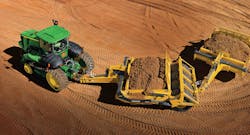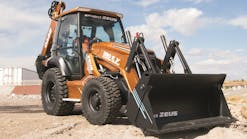Trailers for hauling construction equipment come in dozens of sizes and types, and they have hundreds of options. If you’re spec’ing a construction equipment trailer, it is probably best to seek out one or more reputable manufacturers and tell their knowledgeable people exactly what you want to haul, what you want to tow it with, and where you want to haul.Considerations such as total weight, weight concentration, length, width, and height become very important. Some trailers are rated for weight that is uniformly distributed. Some loads, like forklifts, are very concentrated. So some trailers are rated for a certain weight over any given length of the trailer deck. Are you going to haul multiple machines, or just one machine, in one load? Is it a tracked machine, or one on rubber tires? Do you want to go off-road with the trailer? Do you want to go over the road into various states?
Computer-Aided Trailer Design
Construction equipment specs are available online. “We volunteer to use AutoCAD, a computer program, to lay out a customer’s machine on a particular trailer, and show approximate weights over axle,” says Matt Laws, national sales manager, Interstate Trailers. “We can see approximate tongue weight transfers, overall heights, and lengths needed on the trailer. There is no room for guesswork. We make sure that if there are questions, we alleviate them prior to building the trailer and delivering it.”
Interstate’s most popular trailers are of the tagalong type. They’re pulled behind a dump truck and used to haul a trencher, or a backhoe, or a skid-steer loader. And they’re rated for an evenly distributed load. Heavy-haul trailers, such as the detachable gooseneck type, are often rated for certain loads over 16 feet, or over 10 feet. “That will dictate what weight you can or cannot put within a span, whether it’s material or a machine,” says Laws.
Interstate manufactures tagalongs, tilt trailers, and lowboys-trailers ranging from a skid-steer loader trailer to a 60-ton detachable gooseneck trailer-and everything in between. “Pierced main beam construction is standard on all of our tag models,” says Laws. “That means cross-members, typically 6-inch I-beams, are pierced through the main rail to create a one-piece, unitized frame. Some of our competitors will use either a 3-inch or 4-inch channel cross member and put those on top of the frame. That gives you less strength and less integrity to the overall frame design.”
Talbert’s Equalizer, which equalizes the load between the trailer and the flip axle, is available on its spread-axle trailers.
Undercoating Standard
All Interstate trailers have undercoating as standard. It’s a corrosion proof coating, almost like an asphalt-type barrier, applied to the underside of the trailer. “That’s really beneficial, especially in the North and Northeast, where they use road salt,” says Laws. (His company is based in Mansfield, TX.)
Oak decking, a sealed modular wiring harness, and LED lights are standard on Interstate trailers. And the company has a relatively new feature: air-assisted ramps, which are available on any air-brake tag-along trailer. In former days, hydraulic assisted ramps were the best you could buy. But they typically use a small 12-V motor and pump on the trailer.
“The drawback to that is that once the battery runs down, if you don’t have the ability to recharge the battery, then the pumps will not work,” says Laws. “However, an air-ramp setup uses air from the truck to operate a bag that inflates. That is attached to a linkage type system that will raise and lower the ramp via the air system from the truck.” Manufacturers say that air ramps are less expensive to build and sell for less money than hydraulic systems.
We asked Laws what trailer he would use for a tracked asphalt paver. “Most of our paving customers spec our Model 40DLA,” says Laws. “It’s a 20-ton, air-brake, dual-tandem, low-profile beavertail and ramp trailer. It’s a tagalong trailer for towing behind a dump truck. For extremely low-incline tracked pavers, we offer an 11-foot, bifold, hydraulic-operated ramp setup.”
Apitong Wood Decks
XL Specialized Trailers builds trailers for a wide variety of applications, says Rodney Crim, South Central sales manager. The company builds lowboys with hydraulic and mechanical goosenecks; folding goosenecks; sliding-axle trailers; step decks and hydraulic and mechanical multiaxle units, plus many more custom units in between those. The capacity of XL trailers generally ranges from 50,000 to 170,000 pounds overall.
“We mean it when we say our trailers are built with top-quality materials and designed with customer-minded features,” says Crim. “Our steel is 80K strength in the webs and T1 in the flanges. And our I-beams are made from one-piece web and flange for increased durability. And we use apitong wood decking, which is stronger than oak.” (Apitong is a Malaysian hardwood.)
Crim says XL’s “go-to construction equipment hauler” is the XL 110 low-profile, hydraulic, detachable gooseneck. “We have added new standard features to our XL 110 Low-Profile HDG,” says Crim. “We have bolster chain slots on the rear deck, 13 chain slots per side and seven bent D-rings per side across the main deck provide many tie-down options. The deck also features removable heavy-duty outriggers for hauling an extra-wide load.” The trailer’s overall capacity is 110,000 pounds overall and 100,000 pounds concentrated in any 10 feet.
Talbert Manufacturing Inc., located in Rensselaer, IN, builds standard trailers ranging from a 10-ton tagalong unit to 55-ton detachable gooseneck lowboys. Greg Smith, vice president of sales and marketing, says Talbert is probably best known for building custom trailers, bigger than 55-ton detachables. “We can get into all kinds of specially built trailers, from 65-ton East Coast 2-3-2 configurations, also known as an 11-axle trailer, up to an 80-ton trailer with a four-axle tractor configuration,” says Smith.
Sliding-Axle Trailers
Talbert also builds sliding axle trailers that are popular in the recovery-and towing business. They’re also used to haul construction equipment. These units feature axles that slide forward and the bed tilts upward. “So at the end of the trailer you have a six- or seven-degree load angle,” says Smith. “And then you have a winch at the gooseneck. So you can haul a dead load off the road. Rental companies love these trailers because one minute they’re hauling a light tower, and the next minute they’re hauling a fork truck, and the next minute they’re hauling a generator. So a rental company can haul all different types of equipment. By using a slide axle, you can get a very low load angle and pull something onto the trailer.”
Trail King makes a full line of detachable goosenecks, in either a hydraulic version or mechanical.
Sliding-axle trailers feature two axles if it’s a 35-ton unit and three axles if it’s a 50-ton trailer. All of the axles slide forward as one assembly. Smith says the construction industry uses these trailers to haul pavers.
Smith says Talbert’s flagship trailer is the 55SA, a 55-ton-capacity lowboy. A wide number of variations have been created from the base unit, including multiple deck types. “It’s also spread axle capable so that you can put a mechanical spreader bar on it and attach another axle to the back,” says Smith. “So it gives you the ability to have not just a three axle trailer but a three-plus-one style. And we make that trailer with a raised center deck, a level deck, one that has auxiliary cross-members, and so forth.” (Auxiliary cross-members will enable the trailer to carry heavy load concentrations where the cross-members have been added.)
Continual Load Distribution
For Talbert trailers, spread axles (sometimes called flip axles) are pulled about 14 feet behind the standard axles. Talbert offers two versions of that extension-a mechanical axle extension that is common on the East Coast. The second version uses a feature that Talbert calls The Equalizer. “It’s a nitrogen-dampened system that has its own power pack,” says Smith. “It replaces that mechanical spreader bar and it uses the nitrogen dampening feature to make sure that you’re equalizing the load between the trailer and the flip axle.”
With The Equalizer, Talbert says, customers gain the benefits of a suspension system that oscillates around a central pivot point to provide proportionate weight distribution in each axle grouping, regardless of varying road conditions-uphill, downhill, or level. Operators can make easy and quick adjustments with The Equalizer, and maintain those settings to maximize loads safely and efficiently.
By hydraulically dampening axle movement and controlling load transfer, The Equalizer suspension system absorbs hauling and loading shocks and provides a greater range of suspension movement for reduced stress and a smoother ride.
“Let’s say you want to get as close to 20,000 pounds on that flip axle and no more,” says Smith. “So you get your load on the trailer, you’ve got your axle extension and your flip all attached to the back of the trailer, and you go back there and set it so that you’ve got 19,000, or maybe 19,500 pounds, on that axle extension.
“You’re now spreading your load out,” Smith says. “You have so much load that’s going to the tractor, through the front of the gooseneck, and you have so much going to the three axles on the trailer, and so much going to the axle extension. And your whole plan would be to distribute that load out so that everything is set up for each axle to maintain the proper weight. Once you set that Equalizer, you can drive, knowing that no matter what happens, you’ll be making the adjustments to keep your load properly distributed.”
Felling offers three different load blocks with its trailers, each with five positions.
Electrostatically Applied Paint
Trail King Industries, of Mitchell, SD, builds a full line of tagalong trailers, utility trailers and tilt trailers-with capacities ranging from 12,000 to 60,000 pounds. In utility trailers the company offers a ramp style and a tilt style. In ramp or tilt utility trailers, capacities range from 12,000 to 14,000 pounds. Capacities in tag-along trailers range up to 60,000 pounds. And in tilt trailers, Trail King makes trailers with capacities ranging from 24,000 up to 60,000 pounds. “We build tags and tilts up to 60,000 pounds, but our standard offering is up to 50,000 pounds,” says national accounts manager Shawn Murtha.
Trail King also makes a full line of detachable goosenecks-in either a hydraulic version or a mechanical gooseneck. Those range up to 60-ton capacities and even more in multiaxle trailers. “I’d say from 35 to 60 tons and up,” says Murtha. “We do build detachables up to 80 and 85 tons.”
Murtha says all Trail King trailers get media-blasted before they are painted with two coats of paint. The bottom coat is a two-part epoxy primer; the top coat is a two-part polyurethane. Both the primer coat and the top coat are electrostatically applied. That means the trailer has a positive charge applied to it and the paint is negatively charged, so that the two attract each other.
Trail King’s leading trailer is a TK 110HDG hydraulic detachable gooseneck unit. It can carry 110,000 pounds of uniform capacity with 110,000 pounds concentrated in any 12 feet of the deck. Goosenecks are available for both three-axle and four-axle tractors. Standard decks are available from 24 to 28 feet long. “And we are a custom-trailer manufacturer,” says Murtha. “We’ll build anything. If somebody wants a trailer at 29.5 feet, we’ll build that as well. Air-ride suspensions and 25K axles are standard on all our detachables. And we use apitong decking. We are the market leader in lowboys.”
Murtha says Trail King’s hydraulic detachable neck trailer has five transport settings. It has a main setting, and two positions up and two positions down. “If you’ve got a heavier load, you want the gooseneck up because the heavier load is going to take out the crown and pitch in the gooseneck and the load deck,” says Murtha. (Crown refers to that upward haunch, or curve, in the center of a trailer deck.)
“Let’s say if you’ve got a 55-ton trailer and you’re only hauling 35 tons, you might set the transport position a little bit lower,” says Murtha. “It’s only 35 tons and it won’t take the crown out of the trailer. So you might set it lower so as to not hit a bridge or something overhead.”
Non-Ground Bearing
Trail King’s hydraulic detachable gooseneck trailer is a non-ground-bearing, self-lifting, detachable gooseneck. “Some of our competitors have a bit cylinder that pushes into the ground to lift up to transport position,” says Murtha. “Ours doesn’t do that. That won’t work well when the ground is soft. Ours is non-ground bearing, all self-lifting. It’s an important feature.”
Entry-Level Trailer
Towmaster Trailers, of Litchfield, MN, builds a full range of trailers from a 3,000-pound capacity roller trailer up to a 120,000 pound detachable gooseneck trailer. “Our most popular models are going to be our 12,000 pound T-12 drop deck trailer and our T-14 drop deck with 14,000 pounds of capacity,” says Chris Pokornowski, sales manager for Towmaster.
“And once you get into our deck-over models, our T-20, which has a 20,000-pound capacity, is a popular model,” says Pokornowski. “And once you get into the detachable lowboys, the 110,000-pound lowboy is the most common in the industry.”
New from Towmaster is the TE model, for Towmaster Entry level. It’s an economy model that sells for less than many upscale trailers. It comes in three models: a 9,000-pound unit, a 10,000-pound one, and a 12,000-pound capacity trailer. “It doesn’t have LED lights. It doesn’t come standard with spring-assist ramps, or storage trays,” says Pokornowski. “It’s really just a stripped-down model for some of the smaller guys who don’t want to pay the big dollars.”
Oak decking is standard, and apitong is optional on Towmaster’s T110TDG trailer, a detachable gooseneck model. “We’ve got the 24-foot well, and in the wheel area, the air-lift axle is a common option,” says Pokornowski. “We offer aluminum wheels, flip axles, and more. Once you get into the big stuff, everybody wants it built just a little bit different from the other guy.”
Quick-Change Load Block
At Felling Trailers Inc., of Sauk Centre, MN, you can buy anything from a 2,000-pound capacity trailer to one that will carry 120,000 pounds. The company makes tag trailers, tilt trailers, and a line of detachable gooseneck trailers. The goosenecks are all non-ground-bearing units.
Felling offers a five-position, quick-change load block on its detachable gooseneck trailer, which enables the customer to set the gooseneck in any of five transport positions. “It’s like a little cam block, and when the gooseneck comes down it’s going to rest in one of these five positions,” says Felling’s Patrick Jennissen. The transport setting will enable varying amounts of weight to be carried by the tow vehicle or by the trailer.
What’s more, Felling offers three such load blocks, each with five positions. So operators can choose from 15 different transport positions. “And you can change the load block out in about five minutes,” says Jennissen. “We have some competitors where it would take two men a full hour to make that change. So depending on scale laws, you can adjust the weight you’re transferring to the truck or to the trailer.” Felling also offers swivel D-rings on the trunnion bolsters.
“Our newest thing is, and we’ve been doing it for a couple of years, is air-powered ramps,” says Jennissen. “It’s an option on all of our deck-over semi trailers. Historically, those were spring loaded. As ramps got heavier over the years, and for safety, they switched to hydraulic ramps. Now, our air-powered ramps have been widely popular. It’s powered by the air supply from the tow vehicle. It’s even green. It doesn’t use hydraulic fluid, and there’s no chance for leaks. It’s less costly to build and to sell.”











